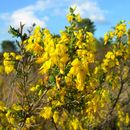Associations
provided by BioImages, the virtual fieldguide, UK
Foodplant / internal feeder
larva of Apion genistae feeds within pod of Genista anglica
Plant / resting place / on
adult of Cryptocephalus labiatus may be found on Genista anglica
Remarks: season: 3-11
Foodplant / parasite
mostly hypophyllous uredium of Uromyces pisi-sativi parasitises live leaf of Genista anglica
Other: minor host/prey
Brief Summary
provided by Ecomare
Needle furze is particularly noticeable by its bright yellow flowers which appear as early as mid April. By the time needle furze starts to wilt, dyer's greenweed begins to blossom. Not that you are likely to mix these plants up. Not only are the flowers of needle furze smaller, the plant has 'needles' (thorns). Needle furze is very common in the Netherlands, particularly on calcium-rich and nutrient-poor sandy soils. It is found in slightly damp heath fields, scanty grasslands and unfertilized roadsides. Needless to say, grazing animals leave this thorny plant untouched. Among other plants and depending upon the dampness, needle furze is often found in the dunes together with crowberry, common heather and cross-leaved heath.
- license
- cc-by-nc
- copyright
- Copyright Ecomare
Genista anglica: Brief Summary
provided by wikipedia EN
Genista anglica, the petty whin, needle furze or needle whin, is a shrubby flowering plant of the family Fabaceae which can be found growing in Cornwall, Wales and eastern Scotland. It is 1 metre (3 ft 3 in) high.
- license
- cc-by-sa-3.0
- copyright
- Wikipedia authors and editors

